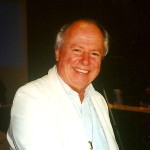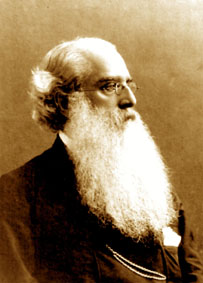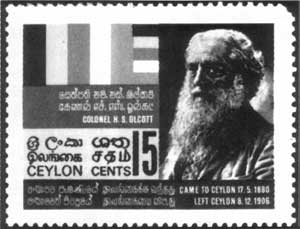Henry Steel Olcott (2 Aug 1832 – 17 Feb1907): The Buddhist Bridge
BIOGRAPHIES, 1 Aug 2016
Rene Wadlow – TRANSCEND Media Service
 There is, in a period of transition, a need for individuals with the specific talents of organization and the ability to translate doctrines into social policy. Henry Steel Olcott was such an individual.
There is, in a period of transition, a need for individuals with the specific talents of organization and the ability to translate doctrines into social policy. Henry Steel Olcott was such an individual.
The last quarter of the 1800s was a period very much like our own — a period of transition with no firm guidelines as to the shape of the period to come. It was a period, like ours, of cross currents, of strong positive and negative movements.
In America and Europe, there was a growing interest in the contribution of Asian thought to the eternal questions of man’s nature and destiny. Yet at the same time others wondered what relevance these Asian doctrines had to the growing social and political problems of the period. Were religions more than the opiate that some suggested they were?
In Asia, where Olcott had moved in 1878 and was most active during his later life, there was the start of the cultural nationalism that has taken a cultural-economic-political form today. But was the intellectual revival of Hinduism and Buddhism only the manifestation of energy displaced from a political area — then under control of colonial powers — which would abandon the cultural sphere once the political realm was open? Would Hinduism and Buddhism be able to translate their doctrines into social policy: projects such as the Christians had been able to do with the creation of schools, hospitals, and social services in Asia, often for the most neglected strata of the society?
The leadership of Henry S. Olcott and the work of the Theosophical Society in quickening cultural life among Buddhists is important as a historical precedent — one which merits attention, not only because of its significance in the past, but also because Buddhist-influenced Southern Asia, from Sri Lanka to Japan, is currently trying to deal with many of these issues.
Colonel Olcott was a distinguished lawyer from a prominent American family, and he remained primarily a lawyer, with a great gift for organizing, throughout his life. The title of Colonel he kept from his war service as an investigator of fraud in the American Civil War. It was a war service that he had undertaken prior to his becoming a Theosophist and Buddhist, but he never renounced the title, for, as with most of his generation who had fought for the Union in the Civil War, he considered the war as a fight against slavery. After 1878, when he had settled in India as President of the Theosophical Society, he worked strenuously against all forms of killing — war, capital punishment, and animal slaughter.
In Ceylon, his legal mind helped him see the inequalities of the colonial system. He believed that British imperialism maintained itself through cultural hegemony. He intervened with the British Governor for better treatment of the people and helped create a Buddhist Defense Committee. At a time when people were interested in colonial areas only if they were professionally involved, he helped to create an interest in the situation of the people of Ceylon with his book, The Government and Buddhists of Ceylon (1884).
It is, however, in the field of social policy that Olcott is best known in Ceylon. From 1886 on, he was active with David Hewavitarane (1865 -1933) in setting up a Buddhist educational fund and the first modern Buddhist-sponsored schools. Until then, all formal modern instruction had been run by Christian missionaries, many of whom were, unfortunately, both aggressive and narrow in the understanding of any faith but their own. These Buddhist-sponsored schools were important factors in the cultural renewal of Ceylon, for they combined modern technical training with a deeper understanding of the religious and cultural heritage of the land. In fact, Olcott was concerned with the cultural life of all in Ceylon. He worked closely with the Hon. P. Ramanathan, a respected leader of the Tamil-speaking Hindus in connection with the possibility of founding a Hindu-Buddhist college that would serve both communities. For financial reasons, the college was never begun. Today, when there is an even greater need for understanding between the two communities, it is important to look at how education can build bridges.
One of the most lasting instruments of this educational concern was the publication of Olcott’s Buddhist Catechism (1881). In many ways a catechism is not a Buddhist way of teaching, which is based more on the interplay of master and student, and the use of ritual. But the Catechism is a noteworthy attempt to accomplish two separate tasks. The first is to present in a simple form the basic teachings of Buddhist thought to the faithful, many of whom had never studied the Dharma in a systematic way. The second and more difficult aim was to translate basic Buddhist doctrine into social policies that could serve as guidelines and recommendations for modern society. One chapter of the Catechism is devoted to the similarities between the Dharma and Western science. This is probably the weakest chapter, and today a good deal more would need to be said on the relationship between traditional Asian philosophies and Western science. In writing the other chapters of the Catechism Olcott depended on the advice of learned Buddhist scholars in Ceylon, but neither they nor Olcott were scientists.
The Buddhist Catechism was widely used. By 1889 it had been translated into 15 languages, mostly those of Asia. It was used as a textbook in many schools. Today, it has gone through forty-five printings, translated into over twenty languages. The success of the Catechism came as a surprise to Olcott himself, for the writing has none of the literary value of Sir Edwin Arnold’s earlier The Light of Asia (1876). Olcott was interested in philosophy, though he was not a philosopher in the formal sense. He saw the need for an improved, widely-accepted teaching tool, and he created it. Olcott also helped to design the five-colored Buddhist flag in 1885: blue for universal compassion, yellow for the Middle Path, red for the blessings of practice, white for purity and orange for liberation.
The same direct approach was used in his work for cooperation among the various traditions of Buddhism. From his extensive travels in India, Ceylon, Burma, and Japan, he saw the need to bring together various schools of thought in the Buddhist world around a certain number of essential points. For nearly the whole month of January 1891, Olcott had brought together representative Buddhist scholars from Japan, Ceylon, Burma, and one representative from Chittagong (then eastern Bengal) to draft a fourteen-point platform of agreement and mutual sympathy. In the same year, the Maha Bodhi Society was created by Olcott’s former student David Hewavitarone, who became the monk Anagarika Dharmapala, carrying much further this worldwide task of teaching, of harmonizing, and of cultural renewal. Anagarika Dharmapala was a leading participant in the 1893 Parliament of Religions in Chicago, a first of the major interfaith efforts. He and Olcott had written for the Parliament a book The Kinship between Hinduism and Buddhism (1893) and in preparation for the Parliament, Olcott wrote The Common Foundation of All Religions.
It is likely that today, when contacts among different schools of Buddhist thought are more common than in 1891, the area of agreement would be greater. But what characterized the life of Henry Steel Olcott was the ability to see a crucial problem and then to organize with others to solve it.
__________________________________________
René Wadlow, a member of the Fellowship of Reconciliation and of its Task Force on the Middle East, is president and U.N. representative (Geneva) of the Association of World Citizens and editor of Transnational Perspectives. He is a member of the TRANSCEND Network for Peace, Development and Environment.
This article originally appeared on Transcend Media Service (TMS) on 1 Aug 2016.
Anticopyright: Editorials and articles originated on TMS may be freely reprinted, disseminated, translated and used as background material, provided an acknowledgement and link to the source, TMS: Henry Steel Olcott (2 Aug 1832 – 17 Feb1907): The Buddhist Bridge, is included. Thank you.
If you enjoyed this article, please donate to TMS to join the growing list of TMS Supporters.

This work is licensed under a CC BY-NC 4.0 License.

